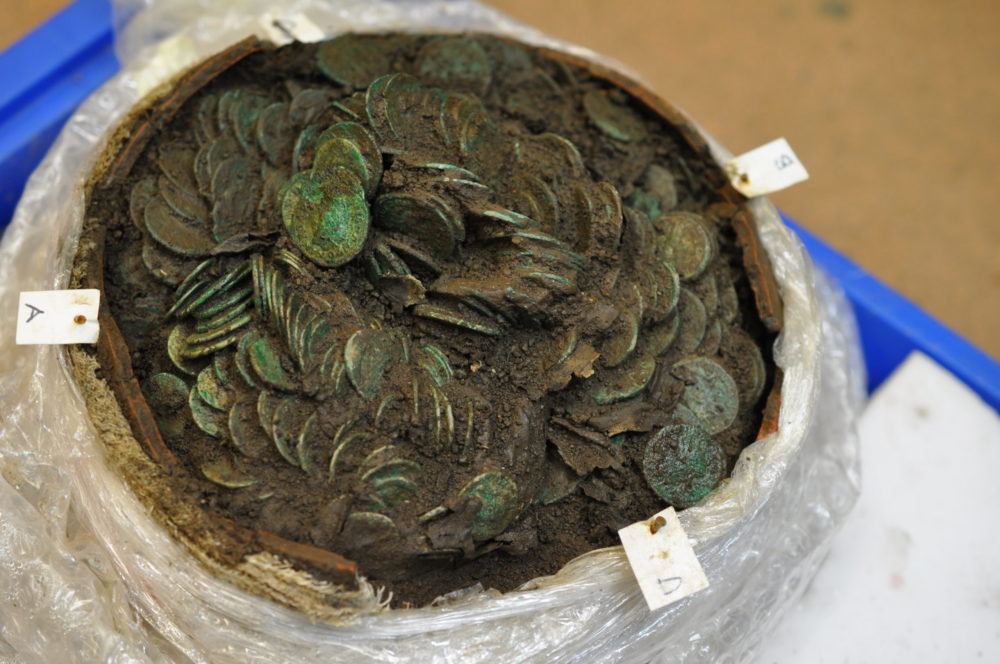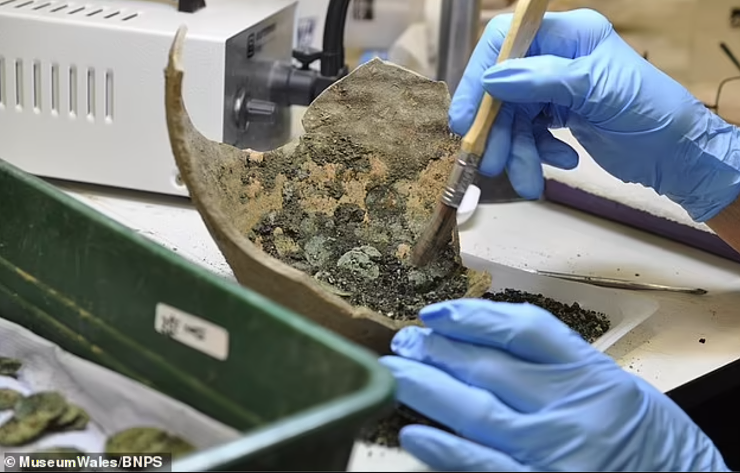A můj první nález byl Frantův sežranej čtvrtkrejcar...o tom nikdo nepíše 
Beginner detectorists discover two Roman treasures
Categories: Nálezy nejenom s detektorem ve Velké Británii a Irsku
Friends David Moss and Tom Taylor were searching with their detectors in a field near Caerhun when they came across a jar full of Roman silver and copper coins. A little later they found more denarii scattered loosely in the topsoil nearby. Both sets were handed over to the PAS liaison officer and now their finds have been declared treasure by the coroner.
The first set in the jar contained 2,733 silver denarii minted between 32 BC and AD 235 and copper alloy coins issued between AD 215 and 270. These were placed loosely in the pot, while most of the silver coins were placed in two leather bags at the very top of the treasure jar. A smaller set discovered later contained 37 silver denarii dating from 32 BC to AD 221, which were found scattered in a small area near the first hoard.
When finders Tom and Dave stumbled upon the treasure, they remembered the popular show Time Team. They carefully excavated the jar, wrapped it in foil and reported to Dr Susie White of the Portable Antiquities Scheme in Wales ( PAS Cymru), "We were just starting out in metal detecting when we made these totally unexpected finds. On the day of the discovery, just before Christmas 2018, it was raining heavily so I headed across the field towards Tom's to call it a day. When suddenly I noticed a deep and large signal. When I dug away the dirt to reveal the top of the coin jar, it was a huge surprise," said David Moss.
The coins were then taken to Amgueddfa Cymru - Museum of Wales where they were cleaned, conserved and identified. In the laboratory, an examination of the top of the pot revealed that some of the coins were in bags of extremely thin leather, which had left residue: "Organic materials are not normally preserved in the soil, but fragments of seams will provide information about the type of leather used and how they were produced," said Louise Mumford, senior conservator at Amgueddfa Cymru
Before the actual extraction of the coins from the jar, a CT scan was carried out which yielded much more information, including the original layout: "Using our equipment we were able to determine that the coins were in different parts of the vessel. They were so densely packed in the middle of the jar that even our high-powered equipment could not penetrate the entire contents. Nevertheless, we were able to identify some groups of coins and could confirm that only the upper part of the jar was not filled," the conservator added.
During the extraction of the treasure, a series of photographs and 3D models were created. These will be used in further research, publications and exhibitions. "People don't realise the amount of work that goes on behind the scenes of ourof a national museum, from removing the coins to caring for them and identifying them so they can be declared treasure. It's a huge process. To be involved first-hand as finders is an incredible experience," described David Moss.
The coins closer to the bottom of the jar tended to be older, with the youngest coins lying in the upper layers. The hoard was probably deposited in 270 AD, when the Roman Empire was divided between the Central and Gallic Empires, which also included Britain. The last coins of the hoard were minted during the reigns of Marcus Aurelius Claudius Quintillus (220-270) and Victorinus (269-271).
"The coins in this hoard appear to have been collected over a long period of time. Most were put into the pot during the reigns of Postumus (260-269 AD) and Victorinus (269-271 AD.), but the two bags of silver coins seem to have been collected much earlier, in the early decades of 3 AD. Alastair Willis, chief numismatic curator at the National Museum of Wales, said.
The second hoard was probably deposited around 221 AD. Both sets were found near the remains of a Roman building that was discovered in 2013. It was probably a third-century temple. It is very likely that the treasures were placed here because of the religious significance of the site, perhaps as votive offerings or for safe keeping under the protection of the temple deity. The coins may also have belonged to soldiers from the nearby Roman fortress of Canovium.
Roman Nemec
Sources: dailypost.co.uk, herald.wales

Roman treasure in a ceramic vessel

silver coins from the second hoard

excavation from the vessel

ct scan



The article is included in categories:
- Archive of articles > Archaeology > Finds and rescue research abroad > Nálezy nejenom s detektorem ve Velké Británii a Irsku
Post



To je sen... 👀😊
Se picnu. Mně by stačilo půl džbánu 
Ten snímek RTG je mazec 
Moje první mince byla prvorepubliková stříbrna 5 koruna. Říkal jsem si, je to všude! Pecka! Pak jsem několik měsíců Ag nenašel. Bylo to možná ale tím, že jsem používal svůj PI detektor postavený podle Jarchovského.... bez diskriminace :)
Můj první nález byl hliníkovej socpadesátník :D Se samodomo postaveným detektorem DBP 2010. Skončil rozlámanej v popelnici. Byla to hrozná zkušenost, málem jsem tehdy skončil s hledáním :D
Můj první nález byl pújčeným detektorem cvoček od špekáčku. Když jsem poprvé testoval první vlastní detektor koupenej na aukru s dosahem 1 m za 2500,- 🤣 Tak při testování na současný 10ti kačce zahrabaný do krtince....to bylo tenkrát naposled co jsem ji viděl  jsem taky tenkrát málem skončil, nakonec to zachránila stará žehlička
jsem taky tenkrát málem skončil, nakonec to zachránila stará žehlička 

Můj první nález se žluťákem Garrett Ace 150 byla protektorátní koruna. Po měsíci, kdy jsem toho docela dost našel, jsem koupil zde CScope C.S3MX 
Když nepočítám pár kousků zrezlého železa, tak první nález, co za něco stál byl dvouheller. V ten samý den jsem našel ještě čtyři další RU mince a jásal jsem přesně, jak Elmara - Ty vole! To je všude! Mince, kam jen šlápneš!  Týden na to přišlo i první Agčko, trojkrejcar Ferdinanda III a když jsem s ním pak šel za archeologem zkusit dohodnout spolupráci, nafukoval jsem se nad ním, jak žába bučivá
Týden na to přišlo i první Agčko, trojkrejcar Ferdinanda III a když jsem s ním pak šel za archeologem zkusit dohodnout spolupráci, nafukoval jsem se nad ním, jak žába bučivá 
To je mazec premiéra!  Jediný, co jim nezávidím je to permanentně hnusný počasí, ale jinak jsou Ostrovy hledačův zemský ráj.
Jediný, co jim nezávidím je to permanentně hnusný počasí, ale jinak jsou Ostrovy hledačův zemský ráj.  Jo a moje první mince byl krejcar 1812. Taky se o tom nepsalo.
Jo a moje první mince byl krejcar 1812. Taky se o tom nepsalo. 
Můj první nález detektorem byl hliníkový krásný 25h a byla jsem za nějj šťastná  Tohle na fotkách výše je pro mě porno...
Tohle na fotkách výše je pro mě porno... 


Macamica: S trochou štěstí si v tom jednou, dvakrát za život hledač zahraje :)
Můj první nález byla bedna granátů a o kus dál německá helma a mraky kravin spojených s válkou.😭✌️























